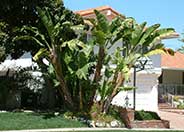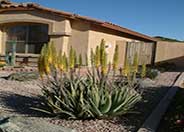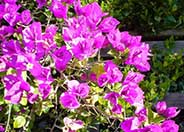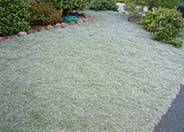
Common name:Giant Bird Of Paradise
Botanical name:Strelitzia nicolai
This clumping evergreen perennial can reach 25' tall fairly quickly, forming a false trunk from the base of the leaves. The leaves are shaped like bananas, reaching 10' long with the widest part reaching 5' . It does best with fertilizer once a month and rich soil. It does not like wet feet so water only when dry. It can be planted in full sun but will do better if it receives afternoon shade. The flowers can reach a size of 10"-12", but plants need to be a few years old before they will flower.

Common name:Aloe Vera or Medicinal Aloe
Botanical name:Aloe vera
The rosette of this plant consists of fleshy gray green leaves, which are narrow, succulent and erect with soft spines on margins. This Aloe is a slow to moderate grower. Flowers are spikes of yellow, 2'-3' tall and bloom late winter to summer. This aloe can form large clumps. It will tolerate full to partial sun, needs some supplemental water in heat and good drainage. It attracts hummingbirds. This aloe is a Mediterranean native. The sap is used for burns and abrasions.

Common name:Bougainvillea selections
Botanical name:Bougainvillea cultivars
This species is hardy and vigorous, with a showy, ornamental display of purple color. It blooms well in areas with cool summers.
It is senstive to frost and will die back hard but comes back in a number of weeks. Be carefeul of this in the Santa Ynez Valley.

Common name:Kangaroo Paws, Red
Botanical name:Anigozanthos hybrids
This tender perennial is a clump-forming evergreen that produces fuzzy, yellow green flowers that bloom in spring and last for over 2 months. Many sizes and varieties are available including yellow and pink flowers.

Common name:Dymondia, Rock Ditty
Botanical name:Dymondia margaretae
This foliage is gray/green/silvery; it is a very dense, mat forming ground cover. It tolerates drought, cold, salt spray and poor soils. It's deep rooted and produces small, inconspicuous yellow flowers. Rock Ditty is great for use in between stepping stones or pavers.
Maintenance Tips
Dymondia margaretae is a low, perennial ground cover that forms a very dense mat of silver-green foliage capable of choking out other plants. It stays lower than 2" tall and can spread out to 15". This is a very drought tolerant plant, but it grows much faster and thrives with regular irrigation. The most common maintenance issue with this plant is weeding. It is naturally slow-growing when it is getting established, which allows seeds and other creeping plants to emerge between the plants. Using a pre-emergent can be very effective in keeping weed seeds from germinating, but creeping plants will have to be removed by hand. Regular weeding can keep your Dymondia looking and performing its best. Once the plant has filled in, there is less space for weeds to grow, so the maintenance will decrease over time. Once established, it can creep and grow around the base of other plants. Prune it away from other plants to prevent them from being choked out.
Photographer: GardenSoft
Physical weed control, including mulching, or hand removal protects the watershed from harmful chemicals.
Be sure to fix all leaks promptly no matter how small they may seem.
Drip and other smart irrigation delivers water directly to roots, allowing no excess water for weeds.